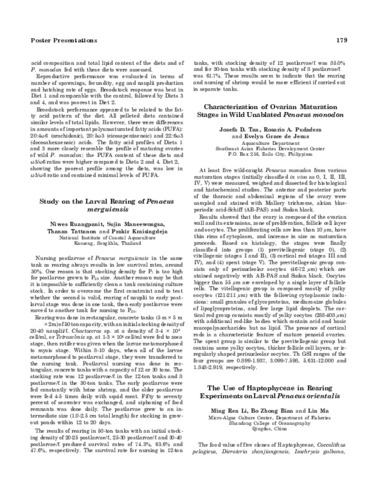The use of haptophyceae in rearing experiments on larval Penaeus orientalis
- Global styles
- MLA
- Vancouver
- Elsevier - Harvard
- APA
- Help
Share
Abstract
The food value of five clones of Haptophyceae, Coccolithus pelagicus, Dicrateria zhanjiangensis, Isochrysis galbana, Tahitian Isochrysis aff. galbana, and Pseudoisochrysis paradoxa were tested for larval Penaeus orientalis. The algae were semi-continuously cultured in 5,000 ml carboys with 4,000 ml of Guillard f/2 medium, under 2,000 lux continuous light and under aeration. The algal density was up to 1 × 107 cell/ml. Rearing experiments were conducted in round tanks with diameter of 45 cm. Algal density was controlled at 1 × 105 cell/ml in the course of the experiments. The larval density was 18 individual/100 ml; water temperature, 21-24°C; pH, 7.5-7.7; and sea water specific gravity, 1.019.
The results showed that of five clones used, Tahitian I. aff. galbana and D. zhangjiangensis proved to be the best. It took 9-11 days for nauplius I to develop into mysis I with survival rate of 73.5% and 73.4%, respectively.
Description
Abstract only.
Suggested Citation
Li, M. R., Bian, B. Z., & Ma, L. (1985). The use of haptophyceae in rearing experiments on larval Penaeus orientalis (Abstract only). In Taki Y., Primavera J.H. and Llobrera J.A. (Eds.). Proceedings of the First International Conference on the Culture of Penaeid Prawns/Shrimps, 4-7 December 1984, Iloilo City, Philippines (pp. 179-180). Iloilo City, Philippines: Aquaculture Department, Southeast Asian Fisheries Development Center.
Type
Conference posterISBN
9718511008




